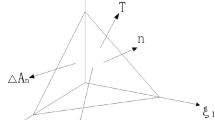Abstract
The paper considers existing approaches to determining conditions for the formation of a wavy profile of the joint surface of metals under explosion. Limitations of the hydrodynamic model due to neglect of the specific properties of welded bodies are discussed. Within the framework of an elastoplastic model, a new criterion of wave formation under explosion welding is proposed. The criterion is based on the assumption that the dynamic yield points of welded metals are equal upon collision.
Similar content being viewed by others
REFERENCES
G. R. Cowan, O. R. Bergmann, and A. H. Holtzman, “Mechanism of bond zone wave formation in explosion-clad metals,” Metallurg. Trans., 2, No. 11, 3145–3155 (1971).
A. A. Deribas, Physics of Explosion Hardening and Welding [in Russian], Nauka, Novosibirsk (1980).
V. M. Kudinov and I. D. Zakharenko, “Criterions for choosing explosion welding parameters,” Svar. Proizv., No. 9, 1–3 (1985).
R. H. Wittman, “The inuence of collision parameters on the strength and microstructure of an explosion welded aluminum alloy,” in: Application of Explosion Energy to the Production of Metals with New Properties, Proc of the II Int. Symp. (Marianske Lazne, CzSSR, 1973), Vol. 1, Pardubice (1973), pp. 155–168.
I. D. Zakharenko, Explosion Welding of Metals [in Russian], Navuka Tékhnika, Minsk (1990).
G. R. Abrahamson, “Residual periodic deformations of a surface acted upon by a moving jet,” Proc. of Am. Soc. Eng.-Mech.: Transl. J. Trans. ASME. J. Ser. E 28, No. 4, 45–55 (1961).
I. D. Zakharenko, “Critical regimes for explosion welding,” Fiz. Goreniya Vzryva, 8, No. 3, 422–428 (1972).
A. A. Deribas and I. D. Zakharenko, “Surface effects for oblique collisions of metal plates,” Fiz. Goreniya Vzryva, 10, No. 3, 409–421 (1974).
I. D. Zakharenko and B. S. Zlobin, “Effect of the hardness of welded materials on the location of the lower boundary of explosion welding,” Fiz. Goreniya Vzryva, 19, No. 5, 170–174 (1983).
T. Z. Blazynski (ed.), Explosive Welding, Forming and Compaction, Appl. Sci. Publ., London-New York (1983).
V. M. Kudinov and A. Ya. Koroteev, Explosion Welding in Metallurgy [in Russian], Metallurgiya, Moscow (1978).
Explosion Welding Metals Handbook, Vol. 6: Welding, Brazing and Soldering, Amer. Soc. Metals (1982).
G. V. Stepanov, Elastoplastic Deformation of Materials under Pulsed Loading [in Russian], Naukova Dumka, Kiev (1979).
V. A. Simonov, Explosion Welding Regions. Basic Parameters and Criteria [in Russian], Lavrent'ev Inst. of Hydrodynamics, Sib. Div., Russian Acad. Sci., Novosibirsk (1993).
A. Ya. Krasovskii, Physical Fundamentals of Strength [in Russian], Naukova Dumka, Kiev (1977).
V. S. Sedykh, “Classification, estimates, and relation between the main parameters of explosion welding,” in: Explosion Welding and Properties of Welded Joints (collected scientific papers) [in Russian], Polytechnical Inst., Volgograd (1985), pp. 3–30.
V. S. Sedykh and M. P. Bondar', “Basic parameters of explosion welding and the strength characteristics of welded joints,” Svar. Proizv., No. 2, 1–5 (1963).
É. S. Karakozov, Pressure Welding of Metals [in Russian], Mashinostroenie, Moscow (1986).
V. A. Simonov, “Relation between plastic strain and collision angle for explosion welding,” Fiz. Goreniya Vzryva, 27, No. 3, 91–94 (1991).
V. A. Simonov, “Additional limitations on the explosive welding region,” Fiz. Goreniya Vzryva, 28, No. 1, 110–114 (1992).
A. Ya. Krasovskii, Brittleness of Metals at Low Temperatures [in Russian], Naukova Dumka, Kiev (1980).
V. G. Petushkov, “Strength and plasticity characteristics of some metals under high-rate extension": Author's Abstract of Candidate's Dissertation in Tech. Sci., Inst. Strength Problems, Acad. Sci. USSR, Kiev (1969).
V. G. Petushkov et al., “Mechanical properties of metals in high-rate tension,” Probl. Prochnosti, No. 7, 3–8 (1970).
G. J. Tailor, “The testing of materials at high rates of loading,” J. Inst. Civil Eng. 26, No. 8, 487–501 (1946).
A. G. Ivanov, S. A. Novikov, and V. A. Sinitsyn, “Elastoplastic waves in iron and steel under explosion loading,” Fiz. Tverd. Tela, 1, No. 5, 270–278 (1963).
F. F. Vitman and V. A. Stepanov, “Effect of strain rate on the strain resistance of metals for impact velocities of 10–103 m/sec,” in: Some Problems of the Strength of Solids [in Russian], Izd. Akad. Nauk SSSR, Moscow-Leningrad (1959), pp. 207–221.
Author information
Authors and Affiliations
Rights and permissions
About this article
Cite this article
Petushkov, V.G. Physical Interpretation of Explosion Welding near Its Lower Boundary. Combustion, Explosion, and Shock Waves 36, 771–776 (2000). https://doi.org/10.1023/A:1002810908014
Issue Date:
DOI: https://doi.org/10.1023/A:1002810908014



